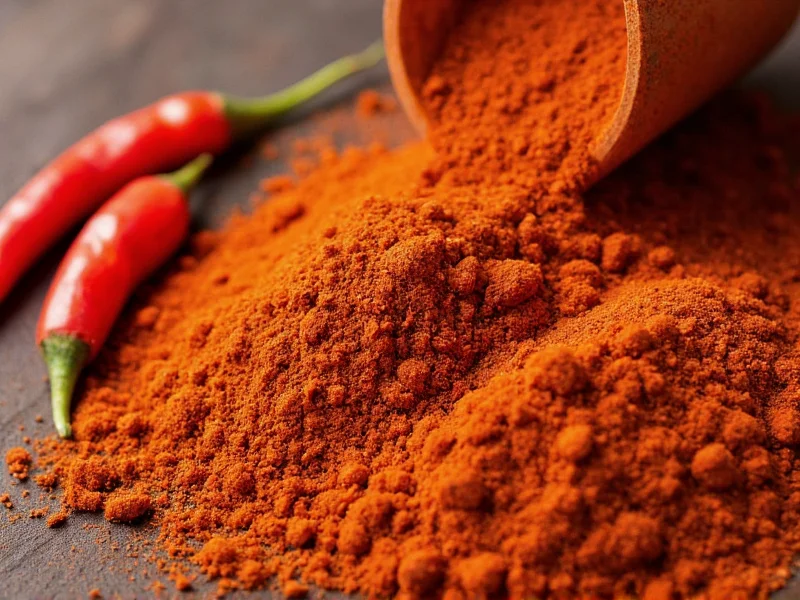Understanding the distinction between cayenne pepper and chili powder prevents culinary disasters and enhances your cooking precision. Many home chefs mistakenly use these terms interchangeably, leading to unexpectedly spicy or bland dishes. This comprehensive comparison examines their botanical origins, flavor chemistry, heat measurements, and practical kitchen applications.
What Exactly Is Cayenne Pepper?
Cayenne pepper comes from Capsicum annuum varieties specifically cultivated for their intense heat. These slender, tapered peppers originated in French Guiana but now grow globally in warm climates. When fully mature and red, they're harvested, dried, and ground into a fine powder with vibrant red color.
The defining characteristic of pure cayenne pepper is its consistent heat level measured at 30,000-50,000 Scoville Heat Units (SHU). This places it significantly hotter than jalapeños (2,500-8,000 SHU) but milder than habaneros (100,000-350,000 SHU). Unlike many spice blends, authentic cayenne contains only one ingredient: ground cayenne peppers.
Decoding Chili Powder Composition
Chili powder creates confusion because its composition varies significantly by region and manufacturer. In the United States, commercial chili powder typically contains:
- Ground mild red chilies (like ancho or New Mexico peppers)
- Cumin (providing earthy notes)
- Garlic powder
- Onion powder
- Oregano
- Salt (in some blends)
This blend generally measures 1,000-2,500 SHU, making it substantially milder than pure cayenne. The inclusion of complementary spices creates a complex flavor profile essential for authentic Tex-Mex and Southwestern dishes. In contrast, Mexican "chile powder" often refers to single-variety ground chilies without additional spices.
| Characteristic | Cayenne Pepper | Chili Powder (US Blend) |
|---|---|---|
| Primary Ingredients | 100% dried cayenne peppers | Mixed chilies + cumin + garlic + oregano |
| Heat Level (SHU) | 30,000-50,000 | 1,000-2,500 |
| Flavor Profile | Sharp, immediate heat with subtle fruitiness | Earthy, smoky, complex with mild warmth |
| Color | Bright red | Deeper brick red |
| Common Culinary Uses | Hot sauces, spice rubs, egg dishes | Chili con carne, tacos, enchiladas |
Practical Substitution Guidelines
Substituting between these spices requires careful adjustment due to their dramatic heat difference. When replacing cayenne with chili powder:
- Use 3-4 times more chili powder to achieve similar heat intensity
- Expect flavor changes from added spices in the blend
- Add separate cumin (¼ tsp per tablespoon) to compensate for flavor differences
Conversely, when substituting chili powder with cayenne:
- Use only ¼ to ½ teaspoon cayenne for every tablespoon of chili powder
- Omit other spices in your recipe to prevent flavor imbalance
- Add ½ teaspoon cumin per tablespoon to maintain earthy notes
Professional chefs recommend creating a custom chili powder blend using 2 parts ancho powder, 1 part cayenne, and ½ teaspoon each of cumin and garlic powder for controlled results.
Nutritional and Health Considerations
Both spices contain capsaicin, the compound responsible for chili heat, but in different concentrations. Cayenne's higher capsaicin content (approximately 12-15%) provides more pronounced metabolic benefits:
- Thermogenic effects may boost calorie burning by 5-10%
- Potential anti-inflammatory properties
- Improved circulation and cardiovascular support
Chili powder offers complementary benefits from its additional spices:
- Cumin aids digestion and iron absorption
- Garlic compounds support immune function
- Blended spices create synergistic antioxidant effects
For therapeutic applications, pure cayenne provides more consistent capsaicin delivery, while chili powder offers broader nutritional diversity through its spice blend.
Avoiding Common Culinary Mistakes
Many cooking errors stem from misunderstanding these spices' properties. Key pitfalls include:
- Using equal measurements when substituting (creates extreme heat imbalance)
- Assuming all "chili powder" products are identical (check ingredient labels)
- Adding cayenne too early in cooking (heat intensifies with prolonged cooking)
- Storing spices improperly (both lose potency within 6 months in clear containers)
For optimal flavor preservation, store both spices in airtight containers away from light and heat. Glass jars in a cool pantry maintain potency significantly longer than plastic containers or spice rack exposure.
Global Variations and Authentic Applications
Culinary traditions worldwide use these spices differently. In Louisiana Creole cooking, cayenne appears in measured amounts in gumbo and étouffée. Mexican cuisine often uses pure ground cayenne ("pimienta de cayena") sparingly as a finishing spice. Traditional chili powder blends vary regionally:
- Texas-style: Minimal spices, emphasizing pure chili flavor
- New Mexico blend: Ancho and pasilla peppers with minimal additives
- Commercial blends: May contain up to 10 additional spices
Understanding these regional differences helps recreate authentic dishes. For true Mexican mole, seek single-variety ancho or guajillo powder rather than American-style chili powder blends.
Practical Kitchen Implementation
When developing recipes, consider these professional techniques:
- Add cayenne gradually in small increments (1/8 teaspoon at a time)
- Bloom chili powder in oil before adding liquids to enhance flavor extraction
- Use cayenne in egg dishes and roasted vegetables for clean heat
- Apply chili powder as the flavor foundation in stews and braises
For spice-sensitive palates, toast whole cayenne peppers before grinding to mellow their heat while preserving flavor. When adjusting heat in finished dishes, dairy products neutralize capsaicin more effectively than starches or sugars.
Conclusion: Strategic Spice Selection
Mastering the cayenne pepper versus chili powder distinction elevates your culinary precision. Remember that cayenne delivers pure, intense heat ideal for targeted spiciness, while chili powder provides complex, rounded flavor essential for traditional dishes. Always check ingredient labels as product formulations vary significantly between brands. By understanding their scientific properties and cultural applications, you'll create more balanced, authentic dishes while avoiding common substitution errors that ruin meals. Keep both spices in your pantry but use them intentionally according to their unique characteristics for optimal cooking results.











 浙公网安备
33010002000092号
浙公网安备
33010002000092号 浙B2-20120091-4
浙B2-20120091-4